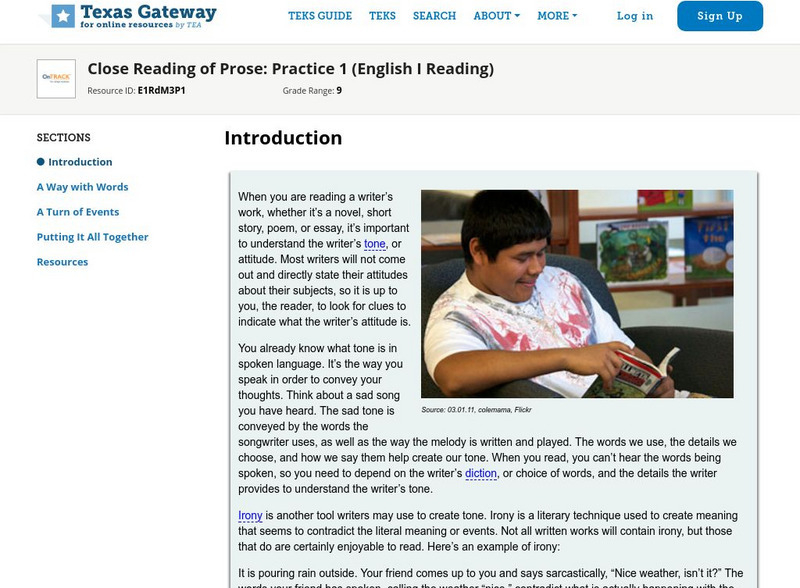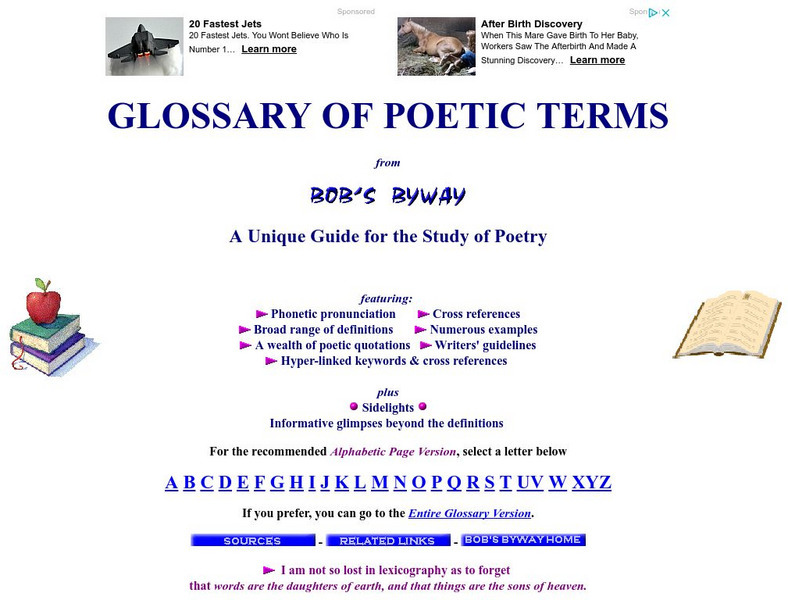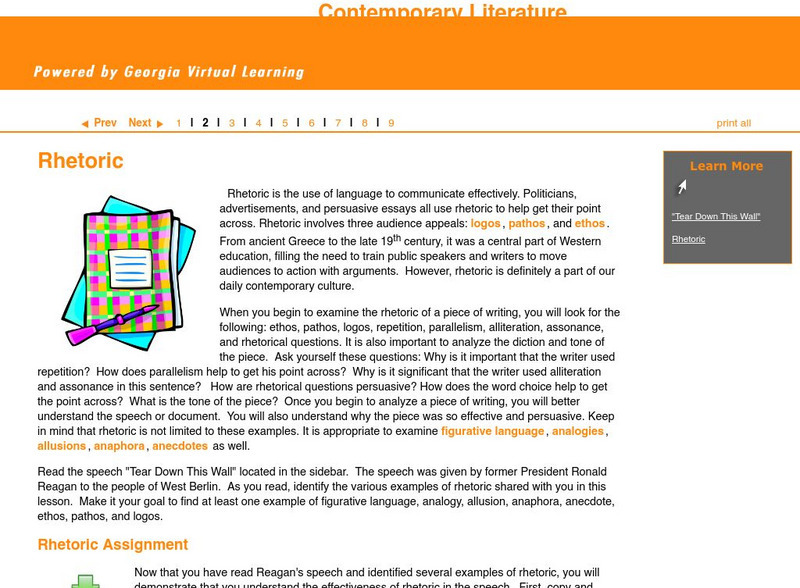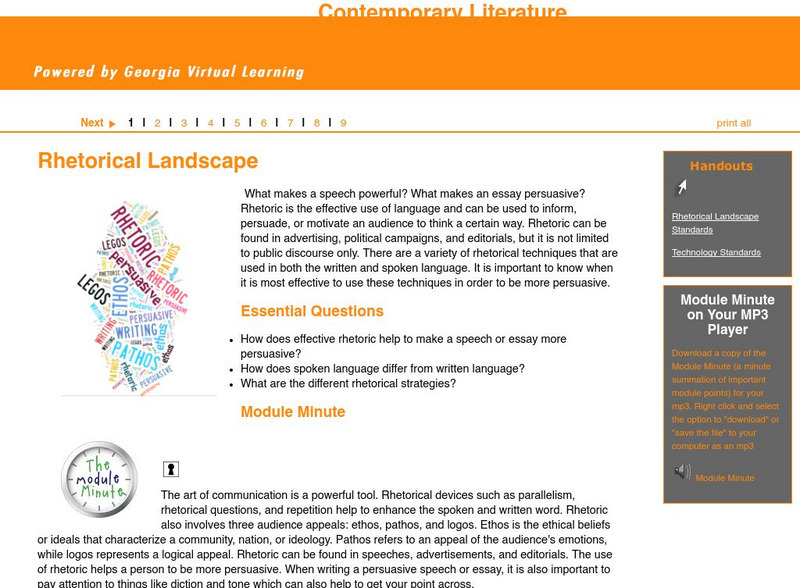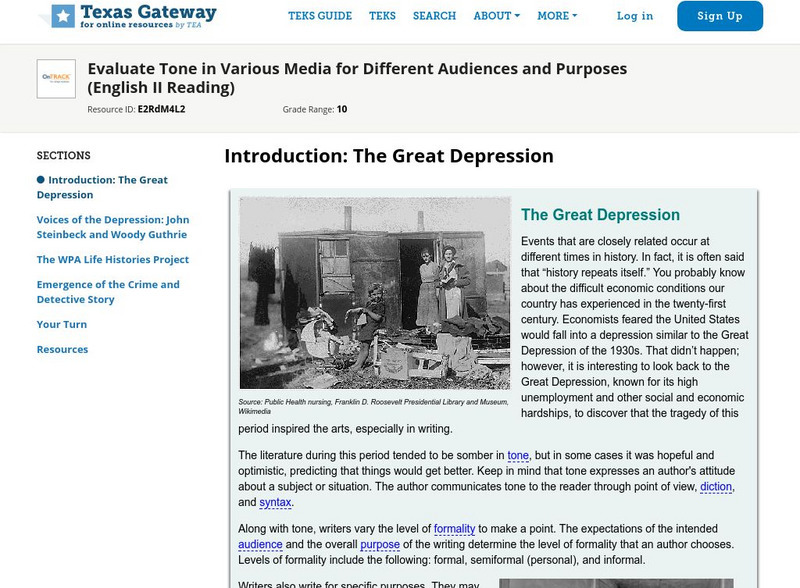Texas Education Agency
Texas Gateway: Diction and Tone (English Iii Reading)
[Accessible by TX Educators. Free Registration/Login Required] In this lesson, students will learn how to find the tone in a passage using a close reading strategy. They will also look at diction and discover that examining a writer's...
Texas Education Agency
Texas Gateway: Diction and Tone (English Ii Reading)
This lesson will help students identify diction and tone in their reading and will help them answer these questions: What does the author mean? What is the author's attitude about what he or she is writing? How will my understanding of a...
Texas Education Agency
Texas Gateway: Literary Text: Diction and Tone
This lesson deals primarily with diction and tone and how to recognize them in your reading. Tone is largely determined by diction or the word choices a writer makes. The process of choosing the right word involves denotation and...
Texas Education Agency
Texas Gateway: Diction and Tone (English I Reading)
In this lesson, you'll see how a writer's tone, diction, denotation, and connotation work together to create meaning for you as a reader.
Texas Education Agency
Texas Gateway: Diction and Tone (English I Reading)
Evaluate the diction in a text and discover the author's tone.
Texas Education Agency
Texas Gateway: Diction and Tone (English Ii Reading)
Evaluate the role of diction and tone in literary nonfiction such as speeches, essays, and other forms.
Texas Education Agency
Texas Gateway:diction and Tone (English I Reading)
In this learning module, the user will learn and apply the concepts of tone and diction. Tone is the author's attitude toward the writing. Tone is largely determined by diction or the words that an author chooses.
Texas Education Agency
Texas Gateway: Tone, Style, and Figurative Language: Practice 5
Mark examples of figurative language and the diction that indicate tone.
Texas Education Agency
Texas Gateway: Identifying Rhetorical Devices in Arguments to Aid Understanding
This lesson focuses on the expression of ideas, the stylistic choices writers make. Because the range of choices is so broad, the activities in the lesson will focus on DDIST: (Diction, Detail, Imagery, Syntax, Tone) to help you remember...
Texas Education Agency
Texas Gateway: Tone, Style, and Figurative Language: Practice 5
Mark examples of figurative language and the diction that indicate tone.
Texas Education Agency
Texas Gateway: Analyze How Author's Style and Syntax Support Meaning
This lesson focuses on understanding an article or essay by looking past mere words on a page to the choice and arrangement of those words in order to analyze the way writers express themselves. The choice and arrangement of words make...
Texas Education Agency
Texas Gateway: Close Reading of Prose: Practice 2 (English Ii Reading)
In this lesson, students practice reading closely so that you can identify the choices that help create tone, diction, and irony.
Texas Education Agency
Texas Gateway: Close Reading of Prose: Practice 1 (English I Reading)
Read carefully in order to identify diction, tone, and irony and evaluate their impact on the meaning of a text.
Houghton Mifflin Harcourt
Holt, Rinehart and Winston: Elements of Literature: Style Chart [Pdf]
A brief organizer in which students can analyze a given selection's writing style. Includes sections on diction, figures of speech, images, and sentence structure.
Texas Education Agency
Texas Gateway: Close Reading of Prose: Practice 1 (English I Reading)
In this lesson, students practice close reading strategies to help them understand a writer's tone. They will examine the writer's choice of diction, details, and irony to identify the writer's attitude.
Texas Education Agency
Texas Gateway: Close Reading of Prose: Practice 1 (English I Reading)
As you read through the texts in this lesson, you will practice close reading strategies to help you understand a writer's tone. You'll be examining the writer's choice of diction, details, and irony to identify the writer's attitude.
Louisiana Department of Education
Louisiana Doe: Louisiana Believes: English Language Arts: Grade 9: Romeo and Juliet
Students explore how patterns and contrasts in language (diction, imagery, figurative language) reveal central ideas in texts and develop various motifs (light vs. dark, dreams vs. reality, high vs. low, etc.) in Romeo and Juliet. They...
Robin L. Simmons
Grammar Bytes: Word Choice Exercises
Students engaging in these 14 word choice exercises will improve their word usage skills. Topics include spelling mistakes, sound alike words and word confusion. Select the correct word usage for each sentence.
Other
Bob's Byway: Glossary of Poetic Terms
Calling itself "unique," Bob's is easy to use, with cross-links throughout, phonetic pronunciation guides when necessary, and many examples and quotations. Click on the letter and scroll for the word.
ClassFlow
Class Flow: Be More Descriptive
[Free Registration/Login Required] This flipchart helps students find synonyms for tired, dull words in order to make their writing more interesting.
Texas Education Agency
Texas Gateway: Tone, Style, and Figurative Language: Practice 5
A learning module that teaches students about tone, style, and figurative language in five mini-lessons: Introduction, Identifying Diction Indicating Tone, Identifying Figurative Language, Spotting Jarring Departures from Tone in Diction...
Georgia Department of Education
Ga Virtual Learning: Contemporary Literature: Rhetorical Landscape: Rhetoric
This lesson focuses on rhetoric; it defines it, discusses rhetorical devices, and audience appeals. It includes a student assignment to read "Tear Down This Wall" a speech by Ronald Reagan and then use the comment feature in Microsoft...
Georgia Department of Education
Ga Virtual Learning: Contemporary Literature: Rhetorical Landscape
This is an introduction to a unit on the use of rhetoric in speaking or writing to persuade an audience to the desired way of thinking or action. If focuses on rhetorical techniques and the three audience appeals: ethos, pathos, and logos.
Texas Education Agency
Texas Gateway: Evaluate Tone in Various Media for Different Audiences & Purposes
This lesson will help you evaluate changes in formality and tone within printed texts written for specific audiences and purposes. It focuses on writing produced during the Great Depression.
Other popular searches
- Dictionary Skills
- Dictionaries
- Dictionary Skills Lesson
- Language Dictionaries
- Computer Dictionaries
- Biography Dictionaries
- Picture Dictionaries
- Acronym Dictionaries
- English Dictionary
- Dictionary and Thesaurus
- +Computer +Dictionary
- Dictionary Use



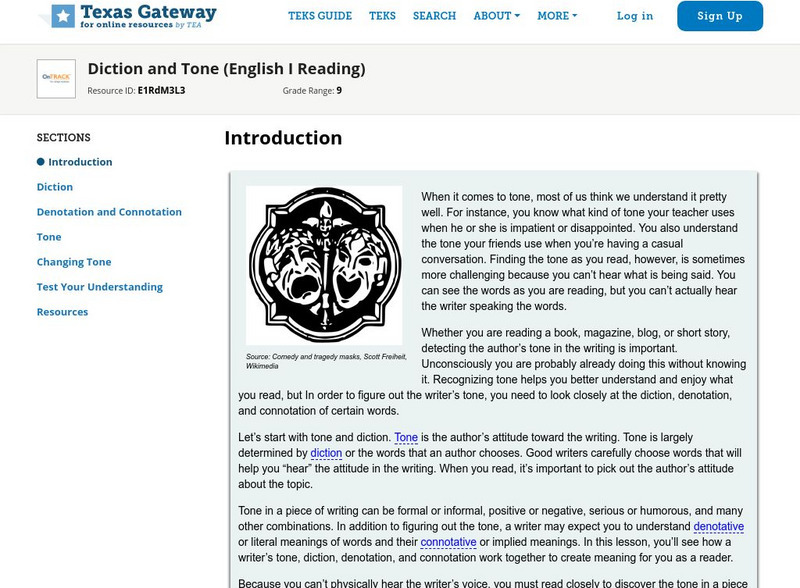


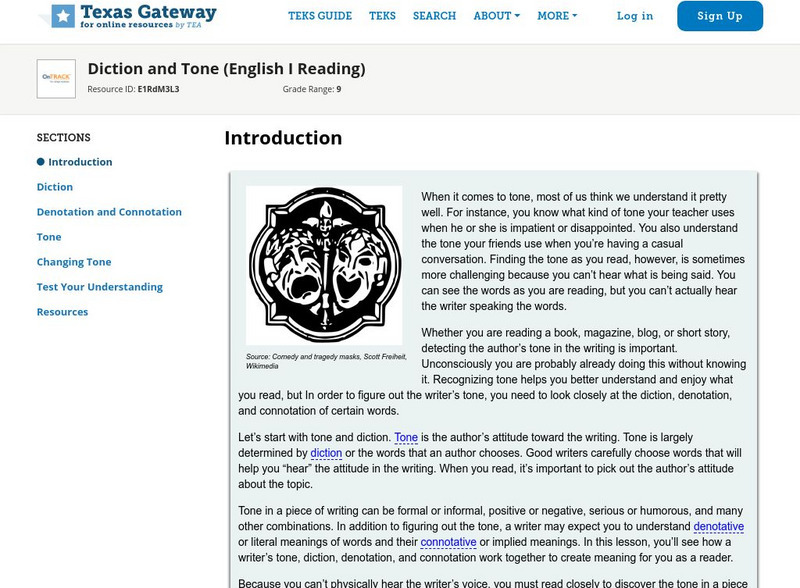
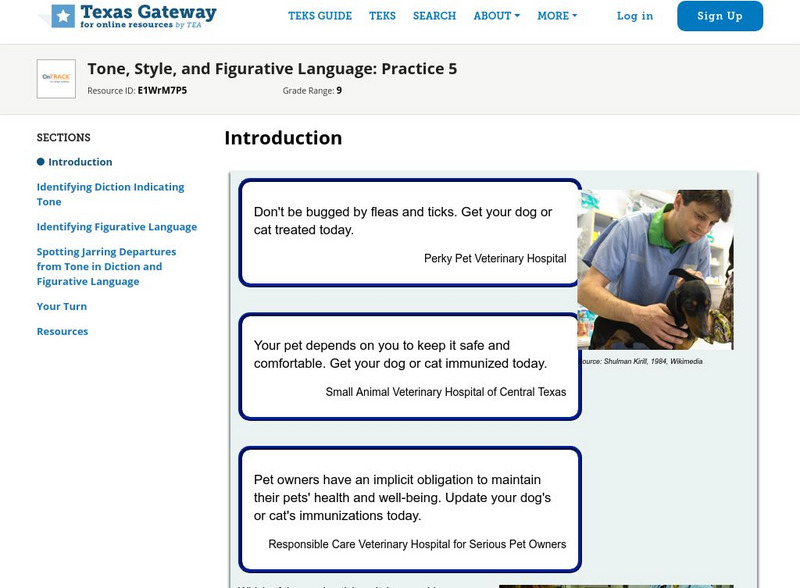
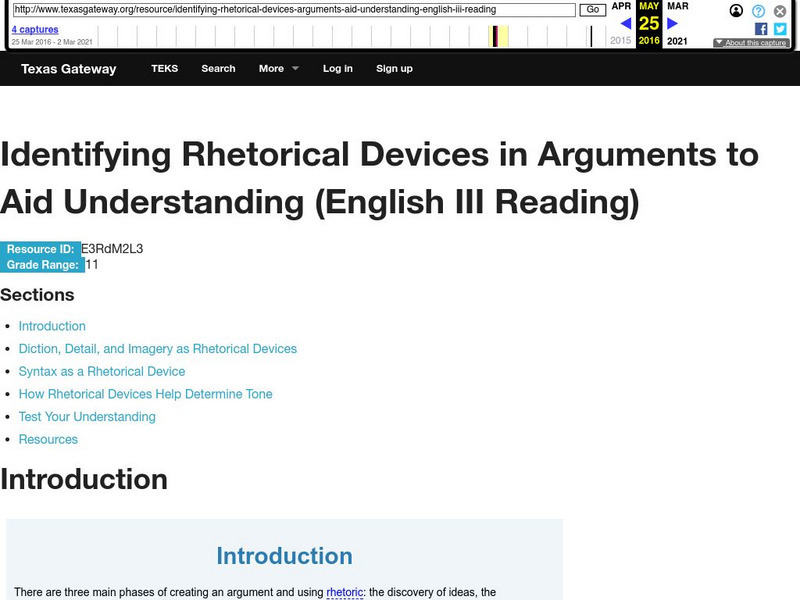
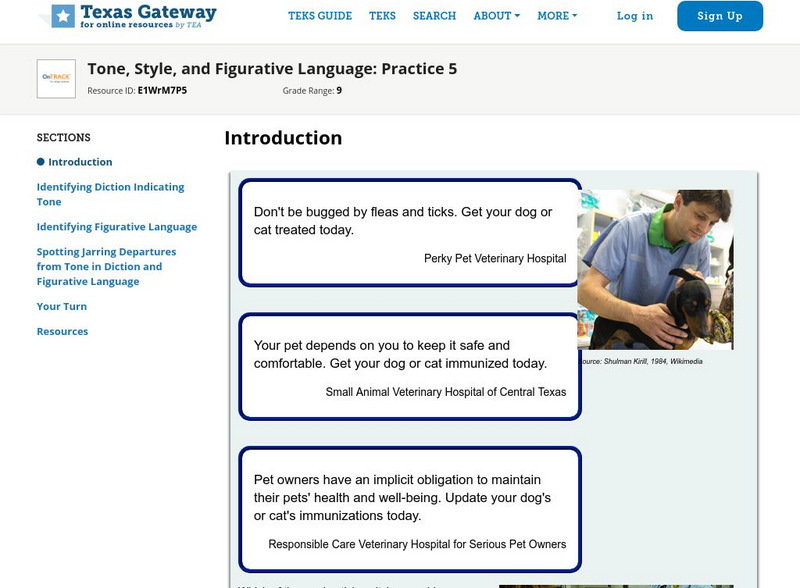
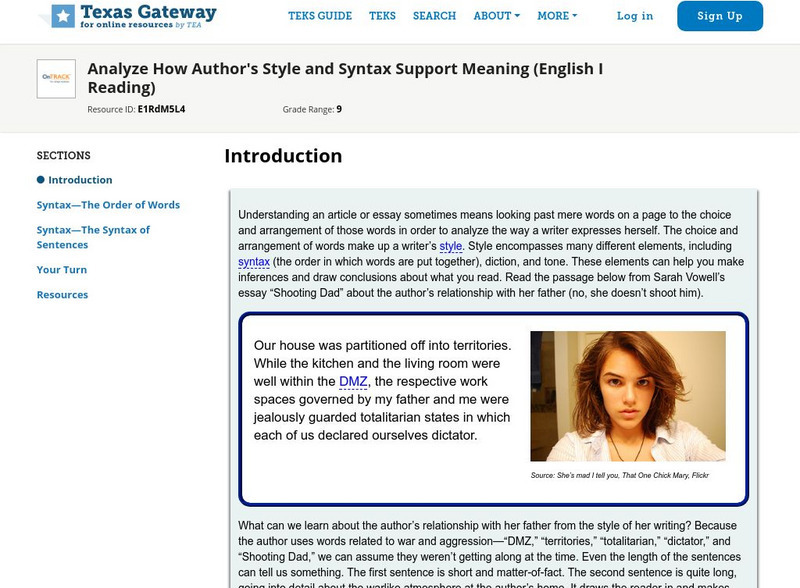


![Holt, Rinehart and Winston: Elements of Literature: Style Chart [Pdf] Graphic Holt, Rinehart and Winston: Elements of Literature: Style Chart [Pdf] Graphic](https://d15y2dacu3jp90.cloudfront.net/images/attachment_defaults/resource/large/FPO-knovation.png)

